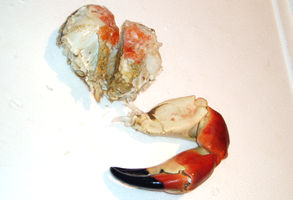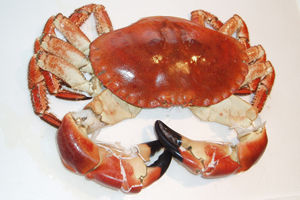
Further suggestions on how to prepare cooked brown crabThe preparation process may seem difficult at first but with practice it will become very easy. You will need a chopping board, wooden mallet, small but strong table knife(with a slightly pointed end) and a seafood fork if you plan to serve the crab meat already picked out. (The opposite end of a stainless steel teaspoon is an alternative - choose one with a narrow end). For opening the crab you may prefer to use very clean rubber kitchen gloves. Be careful using knives! 1. Hold each claw firmly and very close to where it joins the body of the crab - and twist off. 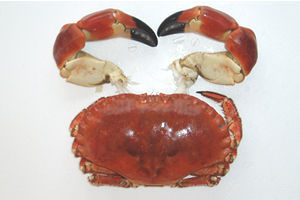 2. Claws - first stage of preparation before meat extraction- each claw is in three sections - hold the first (nearest the body) and the middle (knuckle) - twist and separate. This makes the meat extraction of these two sections with a seafood fork very easy. Watch out for the transparent sliver of 'shell' in the middle of the meat in first section and the pincer section. Put each claw (the pincer section) onto a board on a firm surface, cover with a clean teacloth and with a wooden mallet, crack only the third (pincer) section of each claw just enough to crack the shell but not so much as to break the claw to pieces. Put the claws to one side, preferably in a container sitting on ice cubes to help keep shellfish cool during your preparation. 3. One at a time (maximum of eight) , hold each crab leg very firmly where it joins the body - twist off making sure that the leg socket comes away with the leg and doesn't stay attached to the body. If done correctly you will find extracting the meat from the body cavities much easier. (If the socket remains attached then use your seafood fork to twist off.) 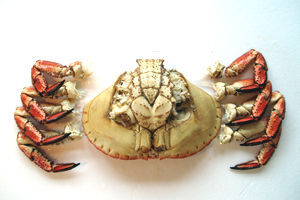 4. After detaching the claws and legs, turn the body upside down. Look for a fine line in the shell that curves around each side of the crab from the back to the mouth parts. Now carefully insert the point of a strong (not bendy) eating knife into this line approx 2 cms around from the back of the crab. If you do this carefully and slightly twist the knife, you will crack the shell along this line. Use the knife to work along the whole line on each side of the crab. When done, open up the crab by separating the upper and lower halves of the outer shell with a gentle prising action. Do this from the rear of the crab. 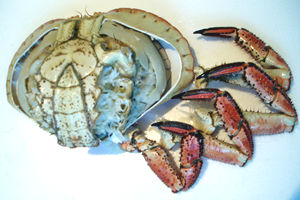 5. Look at the inside of the crab and you will see the slightly grey fingerlike gills. Take each soft gill and completely remove at the base where the gill connects with the internal body shell. Discard these gills to the bin so that there is no chance they will be mixed with the crab by mistake. The gills and the shell (internal and external) are the only parts of the crab which should not be eaten. 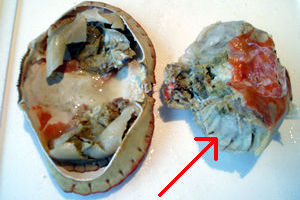 6. If you are extracting all the meat before serving then start removing the crab meat from the claws, legs and body. The brown meat and the red roe (if present) is usually found in the upper part of the out shell. Use a spoon to scoop out and keep separate from the white meat. 7. Please remember that cooked shellfish must be kept cool. Do not leave cooked shellfish lying around, please return to the fridge immediately if you have to leave the job. 8. Please also remember to be very careful not to mix shell with the meat. You should also tell your guests to watch out for shell pieces. If you have decided to have a whole crab meal where you (all) have a more leisurely meal picking the crab as you go then re-assemble/re-arrange the crab parts on a bed of lettuce so that it looks like a whole crab again, cover and put back in the fridge. Serve with French bread, minted new potatoes, mayonnaise and of course a dry English white wine goes well with the meal! |
Some tips for picking out the crab: Claws - each claw is in three sections - hold the first (nearest the body) and the middle (knuckle) - twist and separate. This makes the meat extraction of these two sections with a seafood fork very easy. Watch out for the transparent sliver of 'shell' in the middle of the meat in first section and the pincer section. You do not need to crack all three sections.
If you get stuck, please remember you can always email orders@seafocal.com |
| HOME | Crab or Lobster | How to cook | LOCAL orders | EXPORT orders | ||
|
|
||||||
